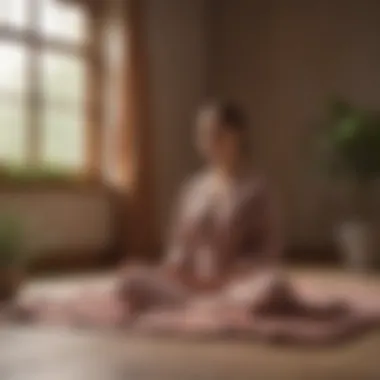Creating a Personal Meditation Space: Insights and Strategies


Intro
Creating a personal meditation space requires more than simply locating a quiet spot. It’s about fostering an environment that reflects tranquility and encourages mindfulness. The design and psychological aspects of this space play a crucial role in enhancing the meditation experience. This guide aims to unveil the essential components, environmental factors, and practical strategies that contribute to an effective meditation space. By understanding the significance of each element, individuals can cultivate a sanctuary for mental clarity and personal growth.
Types of Guided Meditation
The approach to meditation can vary significantly. Below are two common types of guided meditation that can inform how you structure your space and practice:
Mindfulness Meditation
Mindfulness meditation focuses on being present in the moment. It encourages individuals to become aware of their thoughts and feelings without judgment. Selecting a designated area with minimal distractions is key for this practice. A simple cushion, a soft mat, or even a chair can be utilized, depending on comfort.
Sleep Meditation
This form of meditation aims to promote relaxation and prepare the body for sleep. It typically incorporates gentle guidance and soothing sounds. Creating a comfortable environment is essential, with dim lighting and perhaps sound machines or calming music to aid the process.
Benefits of Guided Meditation
Engaging in guided meditation offers numerous benefits that can transform one’s mental well-being. Some notable advantages include:
Mental Clarity and Focus
Guided meditation can help sharpen focus and enhance clarity. It allows individuals to clear their minds of clutter, leading to better decision-making and increased productivity. The impact of a well-established meditation space amplifies these benefits as it nurtures a habitual practice.
Improved Sleep Quality
Practicing sleep meditation consistently can significantly improve sleep quality. An appropriate meditation space that supports relaxation can help signal to your body that it's time to wind down, facilitating a smoother transition to restful sleep.
"The environment in which we meditate can significantly influence the effectiveness of our practice, emphasizing the need for a dedicated space."
The End
Establishing a personal meditation space involves understanding the types of meditation that resonate with you. Two primary forms, mindfulness and sleep meditation, each require specific environmental considerations. Engaging in guided meditation opens doors to mental clarity and restful sleep, contributing positively to personal health. With deliberate strategies and thoughtful design, individuals can create a retreat that supports their journey towards mindfulness.
Understanding the Concept of a Meditation Space
Creating a personal meditation space is more than just having a designated area; it involves understanding its essence and its role in enhancing mindfulness practices. This section provides a foundation for why one should consider the various elements that contribute to an effective meditation space.
The concept of a meditation space can be seen from different perspectives. It is not only about the physical environment but also about how that environment influences mental clarity. An effective meditation space fosters tranquility, promotes focus, and allows individuals to escape the demands of daily life. This sanctuary becomes a personal retreat where one can connect with their thoughts and emotions without distractions.
Defining a Meditation Space
A meditation space can be defined as any area dedicated to practices that promote relaxation, reflection, and mindfulness. It does not need to be large or extravagant. In fact, the size of this space is less significant than its atmosphere. Whether it is a corner of a room, a balcony, or an entirely separate room, what matters is that it serves as an oasis of calm. The essentials include comfortable seating, minimal clutter, and elements that resonate personally with the user, such as books or natural scenery.
Importance of the Right Environment
The right environment plays a crucial role in one’s capacity to meditate effectively. A well-designed meditation space can significantly affect the quality of practice, encouraging a peaceful state of mind. A few key reasons highlight its importance:
- Focus: An optimal environment minimizes distractions, allowing for deeper concentration during meditation.
- Calmness: Elements such as natural light, soft textiles, and pleasant aromas create a relaxing atmosphere that enhances the meditation experience.
- Emotional Connection: Personal touches—like items that hold sentimental value—can make the space more inviting and encourage regular use.


Key Elements of an Effective Meditation Space
Creating a meditation space requires careful thought and consideration. It is not only about finding a quiet corner; it's about creating an environment that nurtures relaxation and mental clarity. The elements chosen for this space can profoundly influence your meditation practice and overall well-being. By focusing on specific aspects such as location, space size, and seating options, one can establish an area that truly supports the practice of mindfulness.
Location Considerations
Selecting the right location for your meditation space is crucial. The environment around you can either enhance or hinder your ability to focus. Ideally, this should be a quiet spot where distractions are minimized. A room away from high traffic areas, such as bedrooms or home offices, may provide the serenity needed for deep concentration.
When considering the location, think about the natural light. Some prefer rooms with ample sunlight, as it can create a warm and inviting atmosphere. In contrast, others may prefer a darker, cozier corner that feels more private. The choice of location should correspond with what feels most comforting to you.
Also, consider accessibility. The meditation spot should be easy to reach, encouraging regular use. If the space requires too much effort to access, it may lead to inconsistencies in your practice, undermining its purpose.
Space Size and Layout
The size of your meditation space plays a significant role in its effectiveness. A larger room can provide a more open feeling, fostering a sense of freedom. However, a smaller space can also be beneficial, as it can feel more intimate and secure. The key is to use the space effectively, regardless of its size.
Layout matters as well. A simple arrangement can work wonders. Clear pathways and open areas allow for movement, whether it be sitting, stretching, or even walking during meditative practice. Keep in mind that the fewer items in the area, the less likely external stimuli will distract you. This can be achieved by maintaining a minimalist approach to furnishings.
Designing Your Meditation Space
Designing a personal meditation space involves much more than physical layout or mere furnishings. It is about creating a conducive environment that aligns with your mental and emotional well-being. Each element, from color choices to lighting schemes, plays a critical role in shaping your experience. Thoughtful design can enhance clarity, promote calmness, and deepen your meditation practice.
Color Schemes and Textures
Color schemes in your meditation space should evoke tranquility and relaxation. Soft, muted tones are generally favorable. Consider shades like gentle blues, soft greens, or warm neutrals. These colors can create a peaceful backdrop that aids in focusing the mind.
Textures also contribute significantly. A mix of soft fabrics and natural materials encourages comfort and warmth. For seating, choose plush cushions or an ergonomic chair. Textured rugs can make the floor inviting and provide a sense of grounding. When you combine color and texture thoughtfully, you can achieve a harmonious ambiance that invites prolonged engagement in meditation.
Lighting and Ambiance
Lighting is another crucial aspect. Natural light is ideal, as it creates a cheerful environment and connects us to the outside world. If possible, position your meditation space near a window. When natural light is not available, use soft, diffused lighting. Avoid harsh fluorescent lights, as they can be distracting. Instead, opt for warm-toned bulbs or dimmable fixtures.
Additionally, consider using candles or LED lights. Soft illumination from these sources can help cultivate a serene atmosphere. You might also want to explore colored lights that could shift according to the time of day or your mood. The right lighting choice supports relaxation and enhances your meditation experience.
Incorporating Natural Elements
Integrating natural elements into your meditation space can have profound effects on mental clarity. Plants are excellent choices. They not only purify the air, but also bring life and vibrancy to your surroundings. Consider easy-to-care-for varieties like snake plants or peace lilies, which can thrive indoors with minimal attention.
In addition to plants, incorporating natural materials is beneficial. Features such as wooden furniture or stone decorations can foster a connection to nature. Water features, such as small fountains, can also be soothing. The sound of flowing water may aid relaxation and help drown out distracting noises.
"Engaging with natural elements can enhance the sense of peace and tranquility in your meditation space."
Overall, designing your meditation space thoughtfully maximizes its potential. The right colors, textures, lighting, and natural elements all contribute to an environment that supports your mindfulness practice. By focusing on these factors, you can establish a space that not only encourages meditation but also fosters a sense of well-being.
Mindfulness and Its Role in Space Creation
Creating a meditation space goes beyond merely choosing a location and setting up physical elements. Mindfulness plays a pivotal role in shaping this environment, serving both as a guide and a tool for cultivating the meditative practice. When individuals intentionally approach the design of their space with mindfulness, they inherently understand the need for a setting that nurtures tranquility and focus. This consideration is crucial, as the space becomes more than just a physical area; it transforms into a sanctuary where mental clarity and emotional balance can be fostered.
The act of being mindful allows practitioners to connect their thoughts and feelings to the ambiance of their meditation space. This connection promotes a deeper understanding of how physical surroundings impact emotional states, thus encouraging a tailored approach to space creation. Ultimately, in creating a personal sanctuary for meditation, one encourages a commitment to the practice. An environment nurtured by mindfulness itself becomes a stimulus for ongoing mindfulness.


Psychological Impact of a Dedicated Space
A dedicated meditation space can significantly impact psychological well-being. Studies suggest that when individuals have a specific location designated for meditation, they tend to experience enhanced focus and improved emotional regulation. Such a space serves as a cue for the brain, signaling it's time to engage in contemplation or relaxation. Over time, the brain associates this space with calmness, making it easier to slip into a meditative state.
Benefits include:
- Reduced Anxiety: A regular meditation practice in a designated area helps decrease anxiety levels.
- Improved Concentration: Familiarity with the space aids in focusing thoughts, which is essential for effective meditation.
- Strengthened Routine: Having a specific place contributes to a more consistent meditation schedule.
"A personal meditation space nurtures a calm mind and serves as a refuge from daily stressors."
Establishing such a dedicated area may seem simple, but it requires thoughtful consideration of various factors, such as comfort, aesthetics, and accessibility. The psychological benefits grow as practice is repeated. Each time one enters the space, the mind and body prepare for meditation, creating a potent cycle of mindfulness.
Creating a Routine for Usage
Routine is essential in cultivating a successful meditation practice. Establishing a regular schedule to use the meditation space can enhance its effectiveness. This includes defining specific times during the day for meditation, which helps create a habit. Consistency signals to the mind when it is time to calm down and focus.
A practical approach entails setting reminders or utilizing simple lists to guide the practice. This is how routines can be structured:
- Morning Sessions: Many find morning meditation invigorating, setting a positive tone for the day.
- Evening Reflections: Alternatively, meditating at night can promote relaxation and better sleep.
- Midday Breaks: Short sessions during the day can act as a reset, enhancing productivity.
By establishing a routine that aligns with personal schedules, individuals can fully leverage their meditation space’s potential. The more consistent the practice, the deeper the connection to the space becomes. In this way, mindfulness becomes a natural part of everyday life.
Practical Tips for Establishing a Meditation Space
Establishing a meditation space requires careful consideration and practical steps. The goal is to create an environment that fosters tranquility and mindfulness. It is crucial to address specific elements like decluttering, personalization, and sensory enhancement through aromatherapy and sound. Each of these factors adds to the overall effectiveness of the space.
Decluttering for Focus and Clarity
Decluttering is more than merely organizing items; it is about creating a sense of space that encourages focus. A cluttered environment can create distractions, making it difficult to concentrate during meditation.
- Remove unnecessary items: Only keep objects that resonate with calmness and positivity. This could include personal mementos or items that inspire relaxation, while avoiding clutter that can evoke stress.
- Organize thoughtfully: Arrange the remaining items in a way that promotes ease of movement and accessibility. Ensure that nothing obstructs the space where meditation takes place.
This process helps clear both the physical and mental space, allowing for a more profound meditation experience. Research indicates that a clean environment can enhance clarity of thought and focus, which are essential during meditation.
Personalizing the Space
Personalization is key to making a meditation space truly your own. This involves incorporating elements that reflect your personality and preferences. A personalized space can significantly enhance your connection to your meditation practice.
- Choose meaningful decor: Consider artwork, photographs, or symbols that resonate with your intention for meditation. Add items that remind you of peace and happiness.
- Incorporate your favorite colors: Colors affect mood and energy. Choose shades that you associate with calmness. Soft blues, greens, or earthy tones are usually well-received for their soothing qualities.
Personal touches make the meditation space inviting and can strengthen your commitment to practice regularly.
Using Aromatherapy and Sound
Aromatherapy and sound significantly contribute to the overall atmosphere of a meditation space. They engage the senses, promoting relaxation and mindfulness.
- Essential oils: Utilize diffusers with calming essential oils such as lavender, sandalwood, or eucalyptus. Each scent has unique properties that enhance relaxation and help to focus the mind.
- Soundscapes: Incorporate gentle sounds like soft music, nature sounds, or white noise to create a peaceful ambiance. These sounds can drown out distractions and serve as a constant background to your meditation.
Integrating these elements can transform a simple area into a retreat designed for meditation. By engaging the senses, you not only enhance your practice but also create a more immersive experience.


"Creating a personal meditation space should align with your inner self and lifestyle. It is a reflection of your needs and aspirations in your mindfulness journey.
In summary, practical tips for establishing a meditation space emphasize the importance of decluttering, personalization, and sensory enhancement. Each tip contributes to a holistic approach, ensuring an environment that facilitates ongoing mindfulness and mental clarity.
Common Challenges and Solutions
Creating a personal meditation space often involves navigating various challenges. These obstacles can detract from the intended calming experience. Thus, addressing these barriers is crucial to enhance one's mindfulness practice. By acknowledging common challenges, individuals can formulate strategies to foster a more supportive environment for meditation.
Dealing with Distractions
In today’s fast-paced world, distractions can emerge from numerous sources, such as traffic noise, conversations, or even notifications from electronic devices. These interruptions may impede the ability to concentrate fully during meditation. It is important to establish a strategy for minimizing these distractions.
- Identify Source of Distraction
It is essential to recognize what commonly distracts you during meditation. Is it external noise, such as people talking outside your window? Or perhaps an internal distraction, such as your own racing thoughts? Knowing the source can help find effective solutions. - Soundproofing Your Space
Consider ways to reduce noise in your meditation area. For instance, using heavy curtains or sound-absorbing materials can improve the ambiance. You might also think about white noise machines to mask unpleasant sounds. - Establish Boundaries
Communicate your meditation schedule to those around you. Ask for designated quiet time, so they are less likely to disturb you. Being clear about your needs can foster a more conducive environment for your practice. - Practice Anchoring Techniques
When distractions do arise, focus on breathing or using a mantra to refocus your attention. An effective anchor will help you return to a state of mindfulness despite interruptions.
"The environment plays a critical role in the effectiveness of meditation practice."
Space Limitations and Adaptability
Not everyone has the luxury of expansive spaces to create their meditation sanctuary. Limited space can feel like a constraint but can also be a catalyst for creativity. Adapting to your environment can lead to unique solutions that suit your needs.
- Utilize Multi-Functional Areas
Relying on a small corner of a room or a specific nook can work effectively for meditation. Incorporate your meditation space as part of a larger multipurpose area. For instance, a corner of the living room can be a serene spot with a small rug and cushion. - Portable Meditation Solutions
Consider portable elements that can be easily set up and removed. Meditation cushions or portable folding mats can allow flexibility. Having items that you can store away after use may also keep your living space uncluttered. - Adjustable Layouts
A small space doesn’t have to feel cramped. Arrange furniture to allow for openness. Use modular furniture that can be reconfigured as needed. This adaptability can create an inviting atmosphere conducive to meditation. - Embrace Minimalism
Take a minimalist approach to your meditation area. The less cluttered the space, the easier it can be to maintain focus. Simple decor elements with a few personal touches can provide connection without overwhelming the senses. - Innovating Solutions
Think outside the box. Perhaps you could use an outdoor balcony or a quiet corner in a park. Finding alternative spaces can reinvigorate your practice and explore various environments that can enhance your mindfulness journey.
Maintaining Your Meditation Space
Maintaining a meditation space is pivotal for sustaining its effectiveness. A cluttered or neglected area can detract from the peace and focus one seeks during meditation. Regular upkeep ensures that the space remains a sanctuary for reflection and relaxation. Furthermore, it fosters a sense of commitment to personal mental health and well-being, signaling the importance of this practice in one's daily routine.
Taking care of your meditation space involved regularly assessing its overall atmosphere and making necessary adjustments. Consider how the space makes you feel and if it aligns with your intentions. Regular maintenance can lead to deeper meditation experiences and a stronger connection to your self-awareness.
Regular Cleaning and Refreshing
Regular cleaning of the meditation space may seem mundane, but it plays a significant role in the overall experience. It is essential to keep the area free from dust, dirt, and clutter. A clean environment contributes to mental clarity and calmer emotions.
- Schedule cleaning sessions to prevent dirt buildup.
- Dispose of items that do not serve as beneficial to your meditation practice.
- Check for any lingering odors and address them immediately.
Additionally, consider refreshing the space every so often. This can mean rearranging furniture, adding new elements, or changing the color scheme slightly. Such changes can bring renewed energy and help break any stagnation that might develop over time.
Upcoming Trends in Meditation Spaces
The evolution of meditation spaces continues as new trends emerge, catering to the evolving needs of practitioners. Some contemporary trends include:
- Multi-Sensory Spaces: Incorporating soundscapes and scents to fully engage the senses. For instance, using nature sounds or soft music can enhance relaxation.
- Tech Integration: Utilizing apps and devices for meditation guidance, including virtual reality experiences, is becoming more common.
- Outdoor Spaces: Many individuals are seeking outdoor environments for meditation, which often provides fresher air and a connection to nature.
- Minimalist Aesthetics: A focus on simplicity, utilizing fewer but more intentionally chosen elements within the space.
Staying informed about these trends helps individuals personalize their meditation environments. Adapting to the changing landscape can enhance mindfulness and overall experience.
The End
A personal meditation space is more than just a physical location; it represents a commitment to self-care and mental clarity. As discussed throughout this article, the creation and maintenance of such a space play a crucial role in enhancing one's meditation experience.
Reaffirming the Importance of a Meditation Space
Having a designated area for meditation can lead to numerous benefits. First, it establishes a routine. When you designate a specific space for mindfulness, you condition your mind to associate that area with relaxation and focus. This association helps to diminish distractions and enhances your ability to concentrate.
Second, a personal meditation space allows for personalization. By incorporating elements that reflect your preferences — be it colors, textures, or aromas — you create an environment that resonates with you, facilitating a deeper sense of peace.
Additionally, this spectrum of influence extends beyond the time spent meditating. The presence of a calming space can also contribute to your overall mental health, reducing anxiety and promoting emotional resilience.
Overall, creating and maintaining a meditation space is not merely an exercise in design; it is a fundamental strategy in the quest for inner peace and mental clarity. This dedicated space invites mindfulness into your daily life, making it easier to retreat to calm amidst the chaos of modern living.







